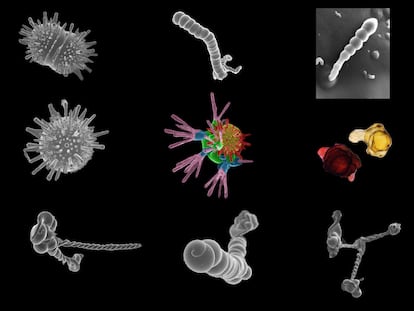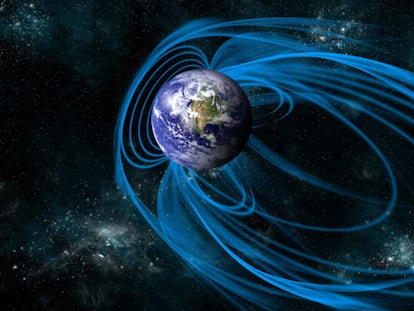The scientist who explains the origin of life with a mineral and without god
Geologist Juan Manuel García Ruiz has received more than $10 million to investigate the role of silica in the emergence of living beings
In 1952, 22-year-old Stanley Miller proposed to his boss one of the simplest and most ambitious experiments in history: to imitate the conditions of the primitive Earth in a glass container and see if something resembling life would emerge from nothing in his laboratory at the University of Chicago. They injected ammonia, methane, hydrogen and water vapor to simulate the atmosphere, applied electrical discharges as if they were storms and “Eureka!”: soon amino acids, the building blocks of life, appeared. The team of Spanish geologist Juan Manuel García Ruiz repeated the experiment in 2021 in a Teflon container and surprised the world: nothing appeared. “The key was the silica in the glass!” exclaims the researcher, who has just received €10 million ($10.8 million) from the EU to study the role of silica (a mineral made up of silicon and oxygen) in the origin of life on Earth.
García Ruiz, 70, constantly talks about the Spanish poet Federico García Lorca, even to explain his own studies. The geologist has lived more than 30 years in Granada — the birthplace of Lorca — where he works as a researcher at the Andalusian Institute of Earth Sciences. The scientist recites from memory verses from Poet in New York, the 1929 collection of poems in which Lorca denounced the dehumanization of the great industrial city: “Heaven-murdered / Among the snake’s forms / and forms that search for crystal, / I will let grow my hair.”
García Ruiz even refers to Lorca to explain how his own ideas about the origin of life were rejected four decades ago. Around 1979, when the geologist was a student in his twenties at the Complutense University of Madrid, he accidentally discovered amazing microscopic mineral structures, with strange curves and spirals, like Lorca’s sinuous snakes before the imposing straightness of the glass skyscrapers. Those unusual shapes looked like living beings, but they were simply self-assembled precipitates of silica and carbonate in laboratory containers. Nothing like it had ever been seen before.
The geologist recalls that, in a June 1980 issue of EL PAÍS, he saw a historic story: the team of the American biologist William Schopf had announced the discovery of bacteria fossils in an Australian desert region, which would prove that there was life on Earth 3.5 billion years ago. García Ruiz was stunned when he saw the lead photograph: the supposed remains of the first living creatures looked like the mineral structures that had been formed in his laboratory.

Years later, he attended an international conference in Prague on the origin of life to present his discovery. “I was very young, and it was the first time I used a laser pointer. I held the laser at my mouth to speak and pointed with the microphone,” he recalls, laughing. “At the end, a guy told me: ‘Thank you very much, but everything you are saying is completely false.’”
García Ruiz ended up calling those curvilinear mineral microstructures — which looked like living beings, but were not — biomorphs. The young geologist encountered international skepticism. “I said that what are considered the first fossils could simply be self-assembled structures. It took me years to publish. They told me that I was doing the experiments wrong, that there was biological contamination, that it was impossible for something inorganic to have those morphologies,” he recalls. The disbelief, according to the geologist, was due to the deep-rooted belief in two separate worlds: the straight geometry of crystal and the exuberant curvature of life. Like Lorca’s hair in New York.
On August 7, 1996, then U.S. president, Bill Clinton, presented to the world a meteorite of Martian origin. “It speaks of the possibility of life. If this discovery is confirmed, it will surely be one of the most stunning insights into our universe that science has ever uncovered,” Clinton said. NASA scientists argued that the filaments found in the extraterrestrial rock were an indicator of fossilized microbes. García Ruiz, from Spain’s National Research Council (CSIC), insisted that was not the case.
The Spanish scientist claimed victory in 2003, finally publishing his results in the prestigious journal Science. His team had synthesized filamentous and curved microstructures, which looked practically identical to the supposed fossilized bacteria found in formations of the Warrawoona Group, in Western Australia. “There was the idea that the inorganic world cannot take on the complex and curved shapes of microfossils. We prove that it can. Morphology cannot be an unequivocal criterion for identifying life,” he says, during a walk through the exhibition on the British evolutionist Alfred Wallace at the National Museum of Natural Sciences, in Madrid.
García Ruiz’s discoveries cast doubt on the solemn announcement that relics of living beings from 3.5 billion years ago were found in Australia, but the geologist does not question the history of life. His hypothesis is that 4.4 billion years ago — after another planet collided with the Earth and the ejecta formed the moon — there were already large masses of water, with a superficial cap, where the curves of the silica biomorphs facilitated interactions between the first building blocks of life, like the glass container in Miller’s experiment. There are thousands of religions in the world, with thousands of contradictory stories about the appearance of living beings, but García Ruiz believes that none of these incompatible gods are needed to explain the phenomenon. “I am an atheist,” he says.
Starting in May, the Spanish geologist will coordinate the PROTOS project, funded by the European Research Council with almost €10 million. He will leave Lorca’s Granada behind to join the Donostia International Physics Center in Spain’s Basque Country. García Ruiz’s team, together with colleagues from France and Germany, will run countless experiments to understand — even at a scale of millionths of a millimeter — how fluids interacted with rocks on the early Earth, and changed it from a lifeless mineral planet to a world with poets like Lorca. “We are going to reinterpret Miller’s experiment, because he forgot about silica,” says García Ruiz.
Sign up for our weekly newsletter to get more English-language news coverage from EL PAÍS USA Edition
Tu suscripción se está usando en otro dispositivo
¿Quieres añadir otro usuario a tu suscripción?
Si continúas leyendo en este dispositivo, no se podrá leer en el otro.
FlechaTu suscripción se está usando en otro dispositivo y solo puedes acceder a EL PAÍS desde un dispositivo a la vez.
Si quieres compartir tu cuenta, cambia tu suscripción a la modalidad Premium, así podrás añadir otro usuario. Cada uno accederá con su propia cuenta de email, lo que os permitirá personalizar vuestra experiencia en EL PAÍS.
¿Tienes una suscripción de empresa? Accede aquí para contratar más cuentas.
En el caso de no saber quién está usando tu cuenta, te recomendamos cambiar tu contraseña aquí.
Si decides continuar compartiendo tu cuenta, este mensaje se mostrará en tu dispositivo y en el de la otra persona que está usando tu cuenta de forma indefinida, afectando a tu experiencia de lectura. Puedes consultar aquí los términos y condiciones de la suscripción digital.
More information
Archived In
Últimas noticias
The murder of Michele and Rob Reiner: A tale of horrific days in Hollywood
Trump orders a ‘complete blockade of sanctioned oil tankers’ going to and from Venezuela
Not all insomnia is the same: Study identifies five subtypes and paves the way for personalized treatment
The United States designates Clan del Golfo as a foreign terrorist group
Most viewed
- ‘El Limones’ and the growing union disguise of Mexican organized crime
- Christian Louboutin: ‘Young people don’t want to be like their parents. And if their parents wear sneakers, they’re going to look for something else’
- ‘We are dying’: Cuba sinks into a health crisis amid medicine shortages and misdiagnosis
- A mountaineer, accused of manslaughter for the death of his partner during a climb: He silenced his phone and refused a helicopter rescue
- The low-cost creative revolution: How technology is making art accessible to everyone











































